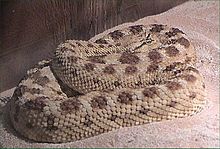| Cerastes Temporal range: Pleistocene-recent[1]
| |
|---|---|

| |
| Desert horned viper, C. cerastes | |
| Scientific classification | |
| Domain: | Eukaryota |
| Kingdom: | Animalia |
| Phylum: | Chordata |
| Class: | Reptilia |
| Order: | Squamata |
| Suborder: | Serpentes |
| Family: | Viperidae |
| Subfamily: | Viperinae |
| Genus: | Cerastes Laurenti, 1768 |
| Synonyms[2] | |
Cerastes is a genus of small, venomous vipers found in the deserts and semi-deserts of northern North Africa eastward through Arabia and Iran.[2][3] Three species are currently recognized by ITIS,[4] and an additional recently described species is recognized by the Reptile Database.[5] Common names for members the genus include horned vipers,[6] North African desert vipers,[3] and cerastes vipers.[7]
- ^ [1]
- ^ a b McDiarmid RW, Campbell JA, Touré T. 1999. Snake Species of the World: A Taxonomic and Geographic Reference, Volume 1. Washington, District of Columbia: Herpetologists' League. 511 pp. ISBN 1-893777-00-6 (series). ISBN 1-893777-01-4 (volume).
- ^ a b Spawls S, Branch B. 1995. The Dangerous Snakes of Africa. Dubai: Ralph Curtis Books. Oriental Press. 192 pp. ISBN 0-88359-029-8.
- ^ "Cerastes". Integrated Taxonomic Information System. Retrieved 30 July 2006.
- ^ The Reptile Database. www.reptile-database.org.
- ^ Mallow D, Ludwig D, Nilson G. 2003. True Vipers: Natural History and Toxinology of Old World Vipers. Malabar, Florida: Krieger Publishing Company. 359 pp. ISBN 0-89464-877-2.
- ^ Parker HW, Grandison AGC. 1977. Snakes – a natural history. Second Edition. London and Ithaca: British Museum (Natural History) and Cornell University Press. 108 pp. + 16 plates. LCCCN 76-54625. ISBN 0-8014-1095-9 (cloth), ISBN 0-8014-9164-9 (paper).